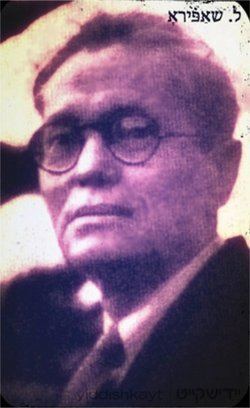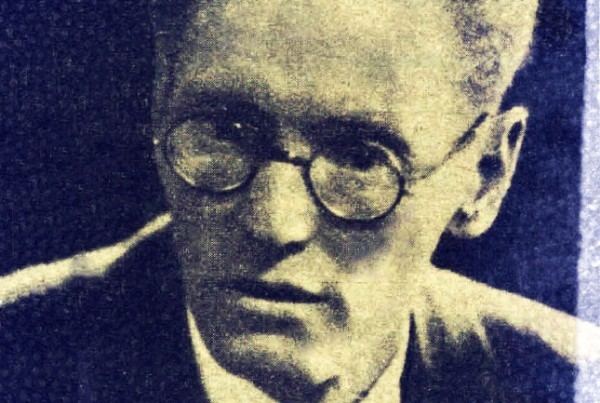Name Lamed Shapiro | Role Writer | |
 | ||
Books The cross and other Jewish stories, Russian-Yiddish Dictionary Similar People Leah V Garrett, Peretz Markish, Itzhak Katzenelson | ||
Lamed Shapiro, Aleksei Granovsky, Yekhiel Shraybman, Leon Kobrin
Levi Yehoshua Shapiro (Yiddish: ל. שאַפּיראָ, born 1878, died 1948), better known as "Lamed Shapiro", (that is, the initial for the Hebrew letter lamed), was an American Yiddish-language writer. His stories are best known for such themes as murder, rape, and cannibalism.
Contents
- Lamed Shapiro Aleksei Granovsky Yekhiel Shraybman Leon Kobrin
- Calendar 9 15 March 2013
- Biography
- Death
- Works
- Critical discourse
- References

Calendar 9--15 March 2013
Biography
He was born on March 10, 1878, in Rzhyschiv, Ukraine. In 1896, he traveled to Warsaw, Poland, struggled to work for two years, then returned to Ukraine. He experienced a pogrom, fell in love and attempted suicide, and was later conscripted into the Czar's army. These experiences would influence much of his rather dark, fictional themes. Shapiro returned to Warsaw in 1903, and I.L. Peretz helped him publish his first literary works: "Di Fligl" (The Wings); and, the next year, a longer story called "Itsikl Mamzer" (Little Isaac the Bastard), published in a journal edited by Avrom Reyzen. To Peretz he would dedicate one of his works, "Smoke", a tale of the Old World (Peretz would serve as an early benefactor of another famous Yiddish writer, Der Nister).
Shapiro left for America in 1905. He stayed for a year in London, where he befriended the Hebrew writer Yosef Haim Brenner. After arriving in New York in 1906, and working for The Jewish Daily Forward, he began publishing his gruesome pogrom tales: "The Kiss" (1907); "Pour Out Thy Wrath" (1908); "The Cross" (1909); "In The Dead Town" (1910). Shapiro's work marks a break from that of the three classic Yiddish writers in its foregrounding of violence and psychological realism, rather than satirical commentary. Shapiro subsequently returned to Warsaw for a year, then returned permanently to the United States in 1911. By 1919, Shapiro had written what are considered his two greatest pogrom stories: "White Challah" and "The Jewish Government." The two stories "remain some of the most aesthetically nuanced and psychologically complex treatments of the pogrom theme in modern Jewish literature."
Shapiro and his family moved to Los Angeles in 1921. His wife died there in 1927, and then he returned to New York. Back in New York yet again, Shapiro worked at several literary periodicals, was active in the Communist party, and was employed by the WPA Federal Writers' Project in 1937. Shapiro returned to LA in 1939, where he lived at 544 Heliotrope Drive in East Hollywood.
Death
Shapiro died in Los Angeles in 1948 while living in a friend's garage. He died an alcoholic and poor. He was buried at the Mount Zion Cemetery in East Los Angeles next to his wife and his tombstone was inscribed with the words: "Lamed Levi Shapiro, Author of the Yiddishe Melukhe".
Works
In English translation
Critical discourse
Curt Leviant, noted translator of Yiddish literature and a novelist in his own right, wrote his MA thesis on Shapiro: “Lamed Shapiro: Master Craftsman of the Yiddish Short Stories”, Columbia University, 1957.
David Roskies, professor of Yiddish literature at The Jewish Theological Seminary, has done critical work on Lamed Shapiro, and places him in the context of World War I-era Jewish writers, like Isaac Babel. See his book, The Literature of Destruction: Jewish Responses to Catastrophe. Jewish Publication Society, Philadelphia, 1989.
